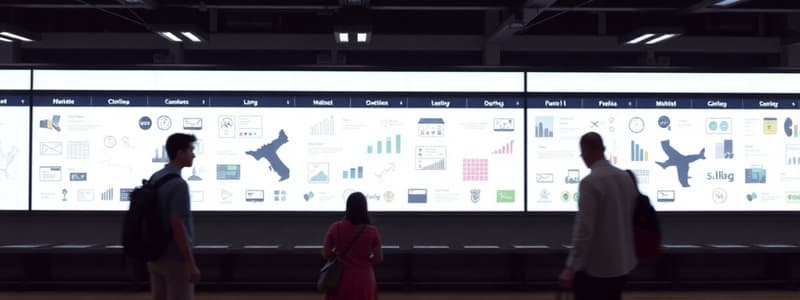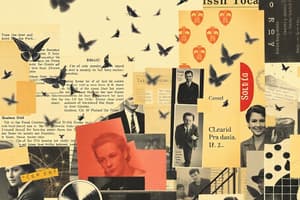Podcast
Questions and Answers
Which of these is a traditional way of sharing information?
Which of these is a traditional way of sharing information?
- Digital libraries
- Oral tradition (correct)
- Social media
- Online surveys
What are stories about the past, that may or may not be entirely true, often referred to as?
What are stories about the past, that may or may not be entirely true, often referred to as?
- Legends (correct)
- Surveys
- Libraries
- Summaries
Which of the following gives a broad overview or condensed version of a topic?
Which of the following gives a broad overview or condensed version of a topic?
- Library
- Summary (correct)
- Culture
- Survey
Which of the following do you call a collection of resources, like books, that is organized for use?
Which of the following do you call a collection of resources, like books, that is organized for use?
What is the term for the beliefs, customs, and social behavior of a particular group of people?
What is the term for the beliefs, customs, and social behavior of a particular group of people?
What research method gathers data from a sample of individuals to understand their opinions or experiences?
What research method gathers data from a sample of individuals to understand their opinions or experiences?
What is knowledge unique to a specific society or culture called?
What is knowledge unique to a specific society or culture called?
Which of the following is a characteristic of indigenous knowledge?
Which of the following is a characteristic of indigenous knowledge?
What is the primary purpose of production in indigenous knowledge systems?
What is the primary purpose of production in indigenous knowledge systems?
Which of the following is a characteristic of indigenous knowledge regarding resource use?
Which of the following is a characteristic of indigenous knowledge regarding resource use?
What is a common ethical perspective within indigenous knowledge systems regarding nature?
What is a common ethical perspective within indigenous knowledge systems regarding nature?
In indigenous knowledge, how are humans viewed in relation to nature?
In indigenous knowledge, how are humans viewed in relation to nature?
What does 'flexible' mean in the context of indigenous knowledge?
What does 'flexible' mean in the context of indigenous knowledge?
What is a key element of social responsibility within indigenous knowledge systems?
What is a key element of social responsibility within indigenous knowledge systems?
What is the primary function of user services in a library?
What is the primary function of user services in a library?
Which type of library primarily serves college and university students?
Which type of library primarily serves college and university students?
Which of the following is the definition of the internet?
Which of the following is the definition of the internet?
Which of the following is an example of an artifact?
Which of the following is an example of an artifact?
What is the purpose of a patent?
What is the purpose of a patent?
What is the use of a diary?
What is the use of a diary?
Which of the following is considered a primary source of information?
Which of the following is considered a primary source of information?
Which of the following is an example of a primary source?
Which of the following is an example of a primary source?
Which of the following is an example of an original document?
Which of the following is an example of an original document?
Which of the following is considered a source of information?
Which of the following is considered a source of information?
Which type of source typically offers reflection or analysis of an original product?
Which type of source typically offers reflection or analysis of an original product?
What is the main purpose of survey-type sources?
What is the main purpose of survey-type sources?
What is the purpose of evaluating the 'currency' of information?
What is the purpose of evaluating the 'currency' of information?
Which of the following questions helps assess the 'authority' of a source?
Which of the following questions helps assess the 'authority' of a source?
What does evaluating 'bias' in a source primarily help you determine?
What does evaluating 'bias' in a source primarily help you determine?
Which of the following questions addresses the 'relevancy' of information?
Which of the following questions addresses the 'relevancy' of information?
What aspect of information is assessed when considering its 'appropriateness'?
What aspect of information is assessed when considering its 'appropriateness'?
Flashcards
Indexes
Indexes
Typically found at the end of a set, offering a guide to the contents within.
Primary Sources
Primary Sources
Original works providing reflection or analysis (e.g., research articles).
Secondary Sources
Secondary Sources
Examine or describe something, summarizing and synthesizing primary sources.
Tertiary Sources
Tertiary Sources
Signup and view all the flashcards
Relevancy
Relevancy
Signup and view all the flashcards
Appropriateness
Appropriateness
Signup and view all the flashcards
Currency
Currency
Signup and view all the flashcards
Authority
Authority
Signup and view all the flashcards
Subsistence Production
Subsistence Production
Signup and view all the flashcards
Diversified Production
Diversified Production
Signup and view all the flashcards
Respect for Nature
Respect for Nature
Signup and view all the flashcards
Human-Nature Dependence
Human-Nature Dependence
Signup and view all the flashcards
Knowledge Flexibility
Knowledge Flexibility
Signup and view all the flashcards
Social Responsibility
Social Responsibility
Signup and view all the flashcards
Library
Library
Signup and view all the flashcards
Academic Libraries
Academic Libraries
Signup and view all the flashcards
Oral Tradition
Oral Tradition
Signup and view all the flashcards
Legends
Legends
Signup and view all the flashcards
Culture
Culture
Signup and view all the flashcards
Summary
Summary
Signup and view all the flashcards
Information Sources
Information Sources
Signup and view all the flashcards
Indigenous Knowledge
Indigenous Knowledge
Signup and view all the flashcards
Locally Appropriate
Locally Appropriate
Signup and view all the flashcards
Internet
Internet
Signup and view all the flashcards
Artifact
Artifact
Signup and view all the flashcards
Patent
Patent
Signup and view all the flashcards
Diary
Diary
Signup and view all the flashcards
Audio/Video Recordings
Audio/Video Recordings
Signup and view all the flashcards
Primary Sources (Examples)
Primary Sources (Examples)
Signup and view all the flashcards
Other Primary Sources
Other Primary Sources
Signup and view all the flashcards
Study Notes
- Unscramble Me! is a word puzzle game.
- The goal of the game is to unscramble a word or phrase within 30 seconds to earn 1 point for each correct answer.
- The group with the highest score wins.
- The unscrambled words/phrases in the game were "Oral Tradition", "Legends", "Culture", "Library", "Survey", and "Summary".
- Media and Information Sources covers indigenous knowledge, libraries and the internet.
Objectives
- Distinguish between the different sources of information.
- Realize the value of each source of information.
- Evaluate information from each information source.
How did the Legends, Myths, Folktales, Epics and Folk Songs come into writing?
- Classification Of Information Sources answers this question.
Classification of Information Sources
- Classification of Information Sources include Indigenous Knowledge, Libraries and the Internet.
Indigenous Knowledge
- Indigenous knowledge is the distinctive knowledge kept to a specific group of people.
- Local knowledge, folk knowledge, people's knowledge, traditional wisdom, or even traditional science are other terms used for it.
- Topographies of Indigenous Knowledge includes information that is locally appropriate, and includes restraint in resource exploitation.
- Restraint in resource explotation means production is for only survival needs.
- Topographies of Indigenous Knowledge also includes diversified production systems, where there is no abuse of resources and various strategies are utilized to avoid risks.
- These systems respect for nature, and treat the land as sacred
- Topographies of Indigenous Knowledge show that humans are dependent on nature for survival, because all species are interrelated
- Indigenous Knowledge is flexible, adapts to new circumstances, and open to outside knowledge.
- Further, topographies of indigenous knowledge highlight social responsibility, wherein there are strong family and community ties, with feelings of obligation and responsibility to preserve the land for future generations.
Library
- A library is a building, room, or organization that has a collection, especially of books, music, and information.
- This information can be accessed by computer for people to read, use, or borrow".
- User services link people to the information they are looking for.
- Technical services function in gathering, cataloging, and preparing library materials.
- Computer services function in maintaining databases, software programming, web page design, etc. in the library.
- Administrative services function in managing the library and services, conveying contracts with sellers, supervising library employees, and preparing budgets.
- Academic Libraries attend colleges and universities.
- Public Libraries attend to cities and towns of all types.
- School Libraries attend to students from Kindergarten to Grade 12.
- Special Libraries are located in specific environments such as hospitals, corporations, museums, military, private business.
Internet
- The Internet is a global computer network providing a variety of information and communication facilities.
- It consists of interconnected networks using standardized communication protocols.
Primary Sources
- Primary sources are materials from a certain period which have not been filtered, modified through analysis, interpretation or evaluation.
- Artifacts refer to something made or created by humans, such as a tool or a work of art, especially an object of archaeological interest.
- A Patent is the granting of a right to an inventor by a sovereign authority.
- Diaries are records with distinct entries organized by date reporting on daily activities or other periods.
- Other types of primary sources:
- E-mails
- Interviews
- Journal Articles
- Letters
- Minutes of Meetings,
- Conferences and symposia
- Newspaper articles
- Research survey results,
- Speeches
- Works of art
- Literature, architecture
- Music, websites and original documents (i.e. birth certificates, marriage certificates), photographs, records of organizations
Secondary Sources
- These are written after an original product which usually aim to give reflection or analysis.
- Indexes are typically found as one or more individual volumes at the end of a set, and include indexes, bibliographies, indexing periodicals, and abstracting periodicals. A survey involves the product of examination or description of someone or something.
- Examples of this include reviews, treatises, and monographs.
- Reference types are materials collected from others' works such as encyclopedias, dictionaries, handbooks, manuals and critical tables.
Tertiary Sources
- Tertiary sources involve information which collects and organizes primary and secondary sources.
- These include a bibliography of bibliographies, directories and yearbooks, a guide to literature, and list of research in progress.
Ways of Evaluating Information
- Relevancy looks at whether the information is relevant to the question at hand.
- Appropriateness asks if the information is suitable to one's age and core values.
- Detail questions how much information is needed and is the depth of coverage adequate?
- Currency considers when the information was published or last updated.
- Authority determines who the author of the information is, and what their qualifications are.
- Bias considers why the information was written and if it was written to inform, persuade, entertain, or sell the reader something.
Studying That Suits You
Use AI to generate personalized quizzes and flashcards to suit your learning preferences.




